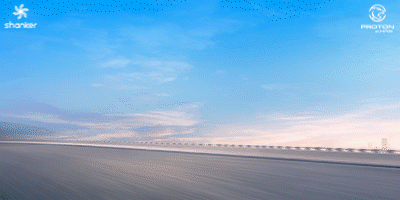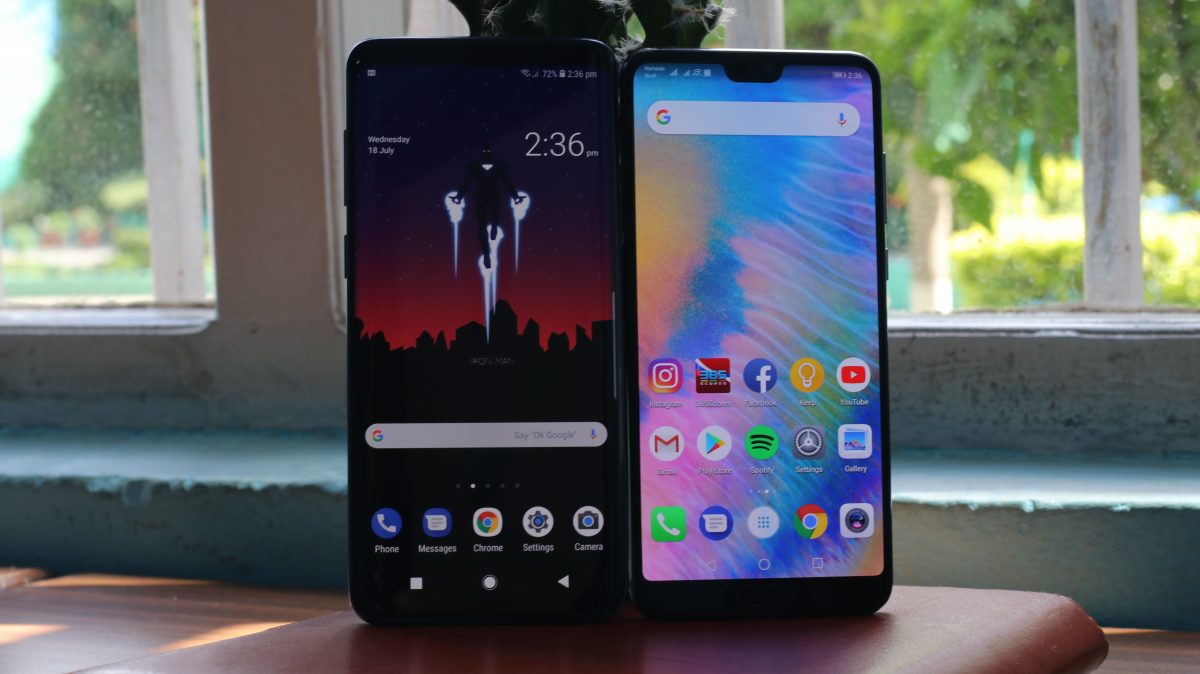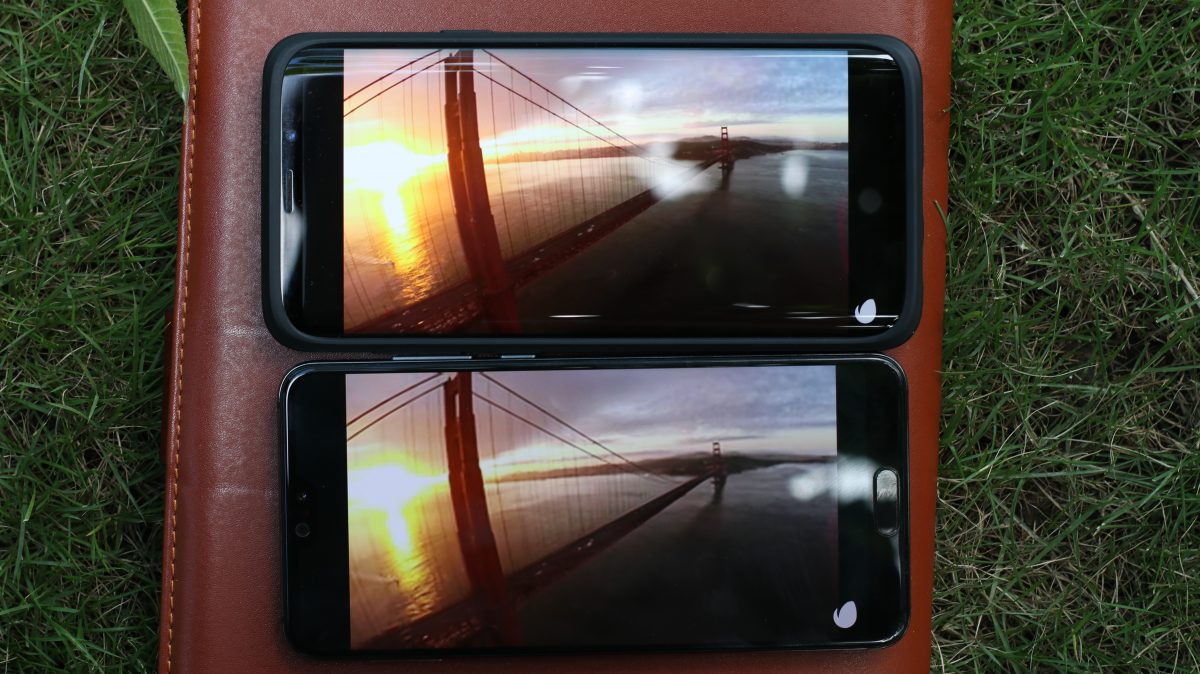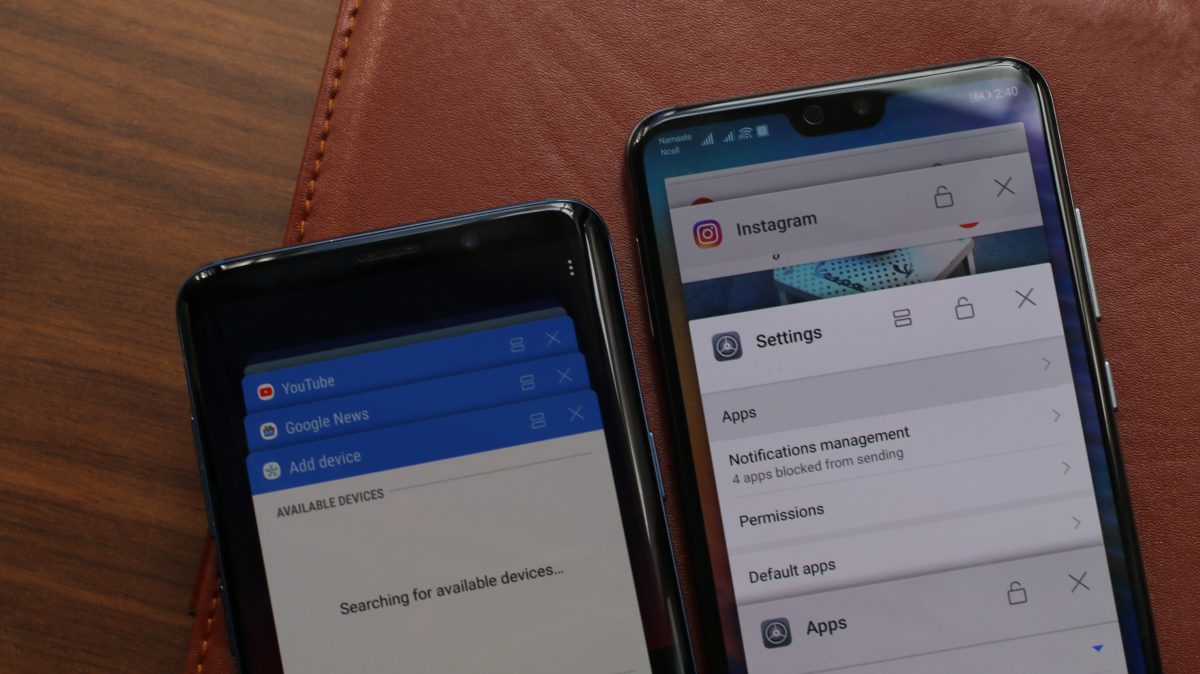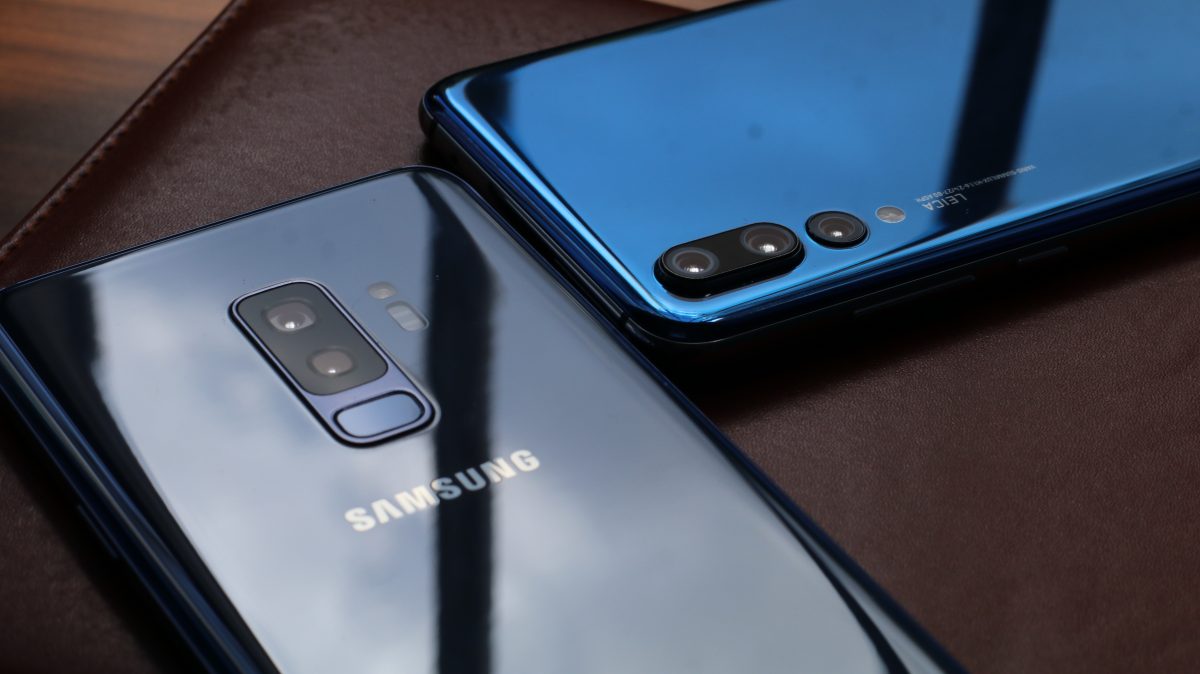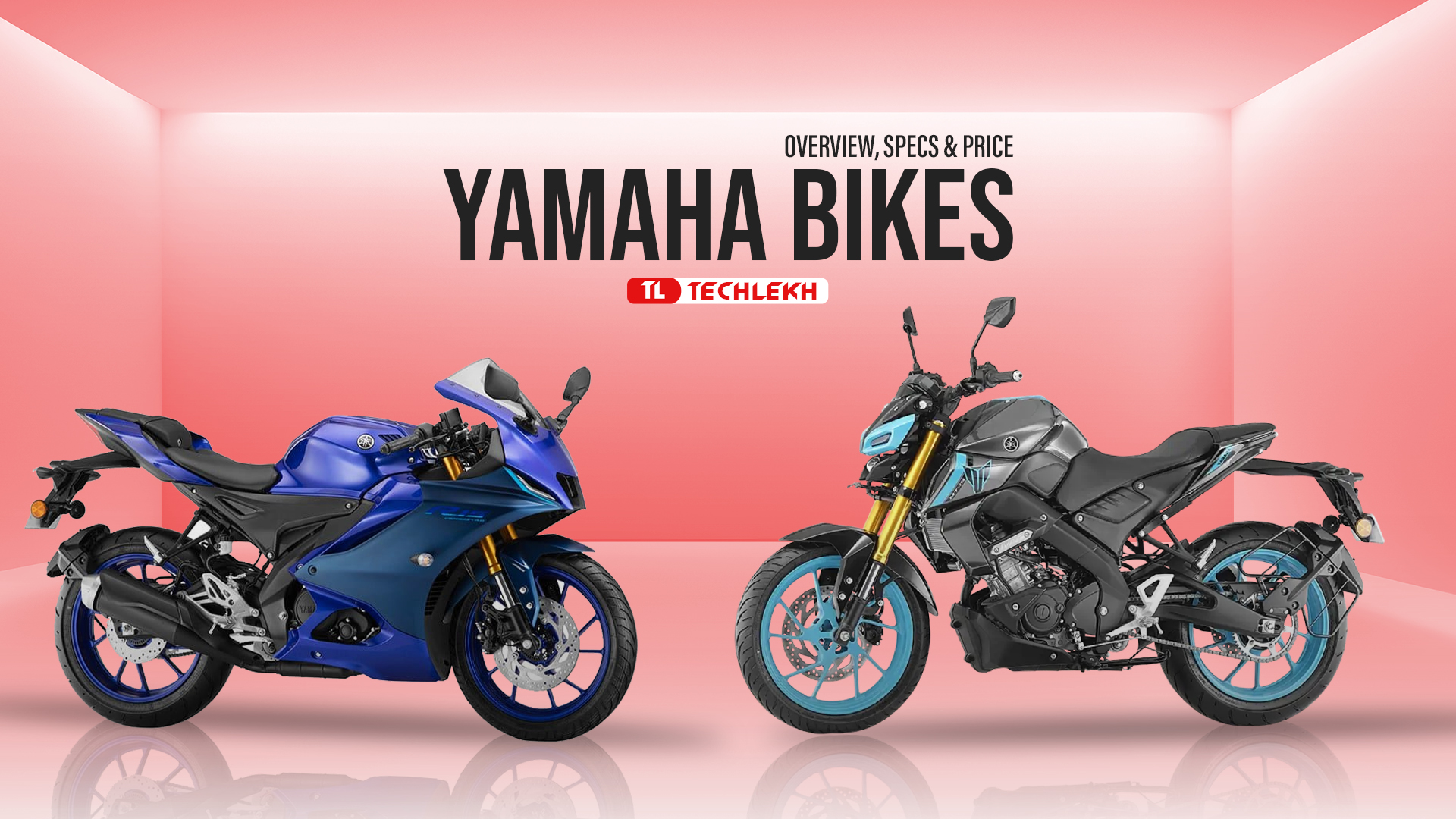Huawei P20 Pro, the first smartphone with a triple camera is by far one of the best premium smartphones. It caught a lot of attention with its DxO Mark rating of 109; the highest among any smartphones & proved to be the best smartphone for mobile photography. Now, the Samsung Galaxy S9 Plus comes second on DxO Mark rating with the score of 99 and uses a variable aperture dual camera setup. Samsung S9 Plus is a refresh to the S8 Plus with a similar design, improved camera, and beefier specs. Whereas, the Huawei P20 Pro is a fresh smartphone from Huawei. Both of these phones are at the apex of the smartphone industry. But, which ones the best? Is it the triple camera setup or the variable aperture dual camera setup? Let’s find out!
Huawei P20 Pro Vs Samsung Galaxy S9 Plus
Specs
Samsung S9 Plus and Huawei P20 Pro trades blow equally in the spec department. S9 Plus mesmerizing variable aperture camera takes on the triple camera setup prowess of the Huawei P20 Pro. It’s great to see manufacturers going for their own chipset; S9 Plus is powered by Samsung’s own Exynos whereas the Huawei P20 Pro is powered by their own HiSilicon Kirin 970.
Both of the flagship phones now come with a stereo speaker with Dolby Atmos support. This has been a welcome addition to most of the flagship phones this year.
| Huawei P20 Pro | Samsung Galaxy S9 Plus | |
|---|---|---|
| Display | 6.1-inch OLED | 6.2 inches Super AMOLED |
| Screen Resolution | 2240 x 1080 pixels (408 pixels-per-inch) | 1440 x 2960 pixels (529 pixels per inch) |
| OS | Emotion UI 8.1 (Android 8.1 Oreo) | Experience UI 9.0 (Android 8.0 Oreo) |
| Internal Storage | 128GB | 64GB |
| MicroSD Card Slot | No | Yes |
| Chipset | Kirin 970 | Exynos 9810 Octa |
| CPU | Octa-core (4×2.4 GHz Cortex-A73 & 4×1.8 GHz Cortex-A53) | Octa-core (4×2.7 GHz Mongoose M3 & 4×1.8 GHz Cortex-A55) |
| GPU | Mali-G72 MP12 | Mali-G72 MP18 |
| RAM | 6GB | 6GB |
| Rear Camera | Triple: 40MP; 20MP; and 8MP | Dual: 12 MP; 12 MP |
| Front Camera | 24MP | 8 MP |
| Video | 2160p at 30 frames per second; 1080p at 30 fps; 720p at 960 fps | 2160p@30/60fps; 1080p@30/60/240fps; 720p@960fps |
| Bluetooth Version | 4.2 | 5.0 |
| Ports | 3.1; USB-C | 3.1; USB-C |
| 3.5mm Jack | No | Yes |
| Fingerprint Sensor | Yes | Yes |
| Water Resistance | IP67 | IP68 |
| Battery | 4000mAh | 3500mAh |
| Colors | Black/Blue/Pink Gold/Twilight | Midnight Black/Coral Blue/Titanium Gray/Lilac Purple/Burgundy Red/Sunrise Gold |
| Price | 99900 | 99900 |
Build & Design
Regarding phones build & design, P20 Pro has a glass back with an aluminum frame. The chassis of the P20 is built very well and its frame sits flush with the glass back. The edges of the phone blend in with the frame smoothly and it’s a triple camera setup looks astounding.
Onto the Galaxy S9 Plus, it’s a familiar build as of the Samsung S8 & S8 Plus. It’s a glass back design with an aluminum frame and their beautiful edge display.
Even with a similar glass back on both of these devices, S9 Plus and P20 Pro have a different finish to their glass body. The one on the P20 pro is slightly more prone to the fingerprint compared to the S9 Plus. But I prefer the finish of the P20 Pro; it’s shinier and looks more appealing than the S9 Plus.
Moving on, P20 Pro feels better in your hands than the S9 Plus. The back of the S9 Plus doesn’t blend in smoothly with the frame, thus it feels slightly weird. Whereas, the P20 Pro’s smooth edges feel more pleasing.
And the most striking design difference is, of course, the triple camera back; it is more interesting compared to S9 Plus’s familiar setup.
Verdict: Huawei P20 Pro
Display
Huawei’s P20 Pro comes with AMOLED screen measuring 6.1-inches with a Full HD+ screen resolution (1080 x 2240) and has a screen ratio of 18.7:9. Whereas, the S9 Plus comes with a 6.2 inches Super AMOLED display with a WQHD+ screen resolution (1440 x 2960) and has a screen ratio of 18.5:9.
The S9 Plus has a slightly larger and significantly sharper display, plus it’s also curved, while the P20 Pro’s is flat.
While the display on the S9 Plus has no notch, Huawei P20 Pro has a notch at the top which takes a slight portion of the screen real estate. It occupies the space in the middle of the notification bar, so you’re unlikely to notice it most of the time.
The vibrancy and depth of colors, light, and shadows are much the same since both have a top-notch AMOLED display.
Since the S9 Plus has a slightly sharper display, we have to give this to the Samsung Galaxy S9 Plus.
Verdict: Samsung S9 Plus
Performance, Battery Life, and Charging
The P20 Pro has Huawei’s own Kirin 970 Processor. It is the first mobile processor with a dedicated NPU (Neural Processing Unit). Huawei’s camera is backed up by the NPU for artificial intelligence (A.I) tasks. Also, the P20 Pro is equipped with 6GB RAM.
Samsung S9 Plus comes with the Exynos 9810. Some benchmarks test show a slightly more power at play for the Exynos 9810, but it doesn’t translate well in real life performance. The everyday performance is similarly super smooth on both of the devices. Both P20 Pro and Galaxy S9 Plus offer 6GB of RAM to keep things going smoothly no matter what you throw at it: games, apps, and multitasking.
Moving into battery life, the P20 Pro has a beefier 4,000 mAh compared to the 3,500 mAh battery. In our testing, the P20 pro outlasted Samsung Galaxy S9 Plus by a slight margin. Even under heavy usage, both of these phones manage to last an entire day. However, under the battery drain test, S9 Plus lasted up to 5hrs whereas the P20 Pro mange’s to outperform it by lasting 5hrs and 20mins.
Both of these phones support fast charging, Quick charging 2.0 on the Samsung Galaxy S9 Plus and Super Charging on the P20 Pro. Huawei’s SuperCharge fast-charging is superior to the Quick Charging 2.0. The S9 Plus takes more than two hours for a full charge whereas the P20 pro manages to charge from 0 to 100 under 1 hour and 30 mins.
The performance is pretty much similar and therefore there’s no definite winner in the performance department. However, P20 Pro’s beefier battery and superior charging have a slight edge over the S9 Plus.
Verdict: Huawei P20 Pro
Camera
With the Huawei P20 Pro, we are getting a triple camera setup with an f1.8 aperture 40MP RGB sensor, f/1.6 20MP Monochrome Sensor, and a f/2.4 8MP telephoto lens. And among these three sensors only the telephoto lens is optically stabilized, whereas the two remaining sensor use AI stabilization.
Now on to the Samsung Galaxy S9 Plus we have a dual camera setup with a variable f1.7-f2.4 12MP lens and an f2.w4 12 MP lens. And both of these are optically stabilized.
Samsung S9 Plus and Huawei P20 Pro are neck to neck when it comes to the camera department. The 40 MP RGB sensor on the P20 helps to capture awesome details and the 5x hybrid zoom is really impressive. P20 Pro is the best camera among smartphones right now and I’ve been impressed with its real-life performance. P20 Pro tries to capture lifelike pictures and thus, it offers natural colors. However, if you want to capture pictures with more popping colors, Huawei lets you do that by switching to Vivid and Smooth color mode on the Camera settings. But you’re stuck with the same color profile option on the Samsung Galaxy S9 Plus, generally, it’s bright and has vibrant colors – not accurate. The images shot on 10MP are sharper than the one shot on 40MP on the P20 Pro, thus pictures shot with 40MP is more pleasing.
Now, let’s talk about that crispy zoom option on the P20 Pro. You’ll get 3x optical zoom and 5x digital zoom on the P20 Pro. The details are well preserved and noise is well under control in 3x optical zoom and 5x digital zoom is also equally convincing. This provides the users with more room to play with the P20 Pro’s camera. You do have a 2x optical zoom on the S9 Plus but P20 Pro’s 3x and 5x zoom gives you more option for different situations.
In low light conditions, P20 Pro and the S9 Plus produce different sort of images. Generally, the picture on the Samsung Galaxy S9 Plus is brighter and it tends to blow out the highlights in some cases. Though the S9 Plus has an improved camera, the low light prowess of the P20 Pro is exceptional. P20 Pro manages to keep the noise level really low and provides nice details to the images even under the low light situation. More than that it handles highlights and shadows really well in night conditions. Samsung Galaxy S9 Plus cannot match the detail level of P20 Pro whereas the noise level is quite similar. Another exceptional low light feature of the P20 Pro is its night mode. This mode exposes the lens for 4 seconds and balances out the shadows with the lights to a sensible degree – a mode no other competitor can match. This mode is kind of an HDR mode for night shots; it’ll provide you with more details and balanced exposure.
Onto the portrait mode, there’s not much to differentiate between the P20 pro and the Samsung Galaxy S9 Plus. Both of these phones perform really well. But, the P20 Pro’s edge detection is slightly better than the S9 Plus. What I dislike about the S9 Plus’s portrait mode is that it zooms in while taking portrait photos, giving you less room to play with.
However, things look better for the S9 Plus when it comes to front camera and videos. We have the 4k option on both of these devices but you do not get the 4k 60fps option on the p20 pro and also there’s no stabilization option on 4k. Whereas you get 4k 60fps option on the S9 Plus and has a very good OIS. There’s slow-mo option on both of the devices, 720p 960fps option on both p20 pro and the S9 Plus. Both of the phones perform have a similar slow-mo effect and therefore there’s no definite winner here.
Photos from the front camera look better on the S9 Plus. In one of the included samples, the skin looks more natural on the S9 Plus and is better than the p20 pro on overall. You have portrait mode for selfies on the P20 Pro whereas it’s called live focus on the S9 Plus. In this case, the P20 Pro has consistent blur and has a better picture overall.
S9 Plus and P20 Pro go head to head when it comes to the camera. But, the P20 Pro certainly has a better rear camera than the S9 Plus. The images have natural color, nice dynamic range and on overall produces pleasing photos. Samsung Galaxy S9 Plus also does pretty well but I prefer the camera on the P20 Pro as the S9 Plus has a warmer color profile and lacks dynamic range.
Verdict: Huawei P20 Pro
Software and Updates
P20 Pro rocks a latest Android 8.1 Oreo, with Huawei’s EMUI 8.1 UI on top. Whereas, the S9 Plus comes with the Samsung Experience UI on top of Android 8.0 Oreo. Samsung has worked on their UI quite well and have improved its UI over the years. Samsung fans will obviously prefer the Experience UI but Huawei’s EMUI has some neat features. And recently, Huawei has been really active when it comes to updates.
Huawei has an inbuilt pedometer that counts the daily steps; it’s really useful for the health freaks. Furthermore, you get Huawei Health if you want to step up your health game. A standout feature that I really like about the P20 Pro and Samsung S9 Plus is their battery saving mode. There are two intensity levels and with the Ultra power saving mode/ Max Power saving mode, you can really make it last longer.
UI is a matter of personal preference but I find it really hard to navigate through the settings of the S9 Plus. It’s much simpler on the P20 Pro. Most of the times I end up having to search for the settings option on the S9 Plus.
Talking about the security features, Huawei P20 Pro has a fingerprint sensor and a face unlock. Similarly, we get fingerprint unlock and intelligent unlock on the S9 Plus. The face unlock on the P20 pro feels ever so slightly faster than the intelligent scan on the S9 Plus. Also, you have to keep your S9 Plus aligned with your eyes for the retina scanner to work well. Certainly, the retina scanner on the S9 Plus is more secured but the face unlock on the P20 Pro is much more practical than the intelligent scan in real life scenarios.
Verdict: Draw
Overall Winner: Huawei P20 Pro
Samsung Galaxy S9 Plus and Huawei P20 Pro are certainly the best smartphones available on the market right now. Both of the phones start at NRs. 99,900; P20 Pro provides you with a larger base storage option with 128GB compared to the Samsung S9 Plus’s 64GB. Samsung S9 Plus has a slightly better display whereas the P20 Pro has a better camera and a slightly better battery. I’ve used both of these devices for a week, and I find it hard to choose the S9 Plus as my go-to daily driver. I prefer the P20 Pro for it is easier to handle with its smaller footprint and I really enjoy the camera on the P20 Pro. Plus, the SuperCharging on the P20 Pro is absolutely amazing. I like how I don’t need to worry about charging my device frequently.
In this round; Huawei p20 pro vs Samsung Galaxy s9 plus, p20 pro is our winner. What’s your pick? Let us know in the comments below!
-
TechLekh Awards: Best Cars of 2025 in Nepal Winners!Electric vehicles continue to dominate Nepal’s market in 2025, and Chinese manufacturers still lead the…
-
Yamaha Bike Price in Nepal (January 2026 Updated)This is the complete list of Yamaha bike price in Nepal for 2026. In this…
-
Suzuki Bike Price in Nepal (January 2026 Updated)This is the complete list of Suzuki bike price in Nepal for 2026. In this…


